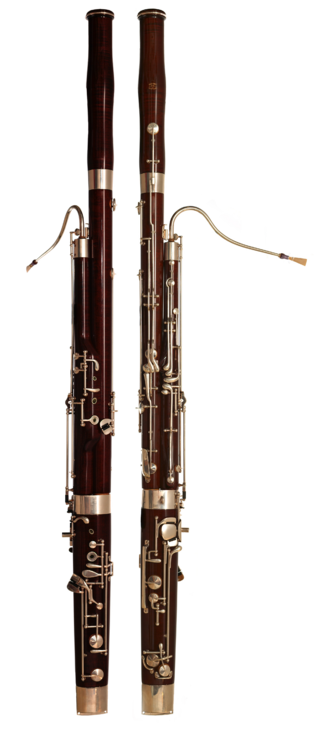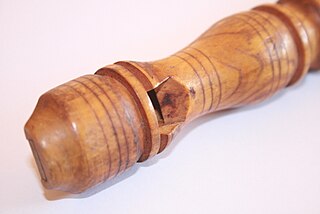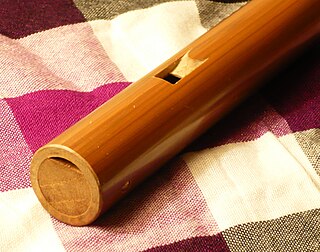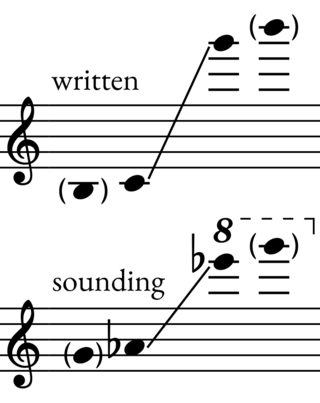
The bassoon is a musical instrument in the woodwind family, which plays in the tenor and bass ranges. It is composed of six pieces, and is usually made of wood. It is known for its distinctive tone color, wide range, versatility, and virtuosity. It is a non-transposing instrument and typically its music is written in the bass and tenor clefs, and sometimes in the treble. There are two forms of modern bassoon: the Buffet and Heckel systems. It is typically played while sitting using a seat strap, but can be played while standing if the player has a harness to hold the instrument. Sound is produced by rolling both lips over the reed and blowing direct air pressure to cause the reed to vibrate. Its fingering system can be quite complex when compared to those of other instruments. Appearing in its modern form in the 19th century, the bassoon figures prominently in orchestral, concert band, and chamber music literature, and is occasionally heard in pop, rock, and jazz settings as well. One who plays a bassoon is called a bassoonist.
The clarinet is a single-reed musical instrument in the woodwind family, with a nearly cylindrical bore and a flared bell.

The flute is a member of a family of musical instruments in the woodwind group. Like all woodwinds, flutes are aerophones, producing sound with a vibrating column of air. Unlike woodwind instruments with reeds, a flute produces sound when the player's air flows across an opening. In the Hornbostel–Sachs classification system, flutes are edge-blown aerophones. A musician who plays the flute is called a flautist or flutist.

The recorder is a family of woodwind musical instruments in the group known as internal duct flutes: flutes with a whistle mouthpiece, also known as fipple flutes. A recorder can be distinguished from other duct flutes by the presence of a thumb-hole for the upper hand and seven finger-holes: three for the upper hand and four for the lower. It is the most prominent duct flute in the western classical tradition.

The tin whistle, also known as the penny whistle, is a simple six-holed woodwind instrument. It is a type of fipple flute, putting it in the same class as the recorder, Native American flute, and other woodwind instruments that meet such criteria. A tin whistle player is called a whistler. The tin whistle is closely associated with Irish traditional music and Celtic music. Other names for the instrument are the flageolet, English flageolet, Scottish penny whistle, tin flageolet, or Irish whistle.

The ocarina is a wind musical instrument; it is a type of vessel flute. Variations exist, but a typical ocarina is an enclosed space with four to twelve finger holes and a mouthpiece that projects from the body. It is traditionally made from clay or ceramic, but other materials are also used, such as plastic, wood, glass, metal, or bone.

The term fipple specifies a variety of end-blown flute that includes the flageolet, recorder, and tin whistle. The Hornbostel–Sachs system for classifying musical instruments places this group under the heading "Flutes with duct or duct flutes." The label "fipple flute" is frequently applied to members of the subgroup but there is no general agreement about the structural detail of the sound-producing mechanism that constitutes the fipple, itself.

The kaval is a chromatic end-blown oblique flute traditionally played throughout the Balkans and Anatolia. The kaval is primarily associated with mountain shepherds.

The vertical flute is either (1) a rim-blown flute, (2) a tubular duct flute, with tapered bore or (3) a transversely blown flute, Giorgi flute, designed to be played in an upright position. The vertical flute is contrasted with the "cross flute" and "globular flute", and in stricter usage may refer only to the first category above.

The tenor saxophone is a medium-sized member of the saxophone family, a group of instruments invented by Adolphe Sax in the 1840s. The tenor and the alto are the two most commonly used saxophones. The tenor is pitched in the key of B♭ (while the alto is pitched in the key of E♭), and written as a transposing instrument in the treble clef, sounding an octave and a major second lower than the written pitch. Modern tenor saxophones which have a high F♯ key have a range from A♭2 to E5 (concert) and are therefore pitched one octave below the soprano saxophone. People who play the tenor saxophone are known as "tenor saxophonists", "tenor sax players", or "saxophonists".

The xaphoon is a chromatic keyless single-reed woodwind instrument. It has a closed cylindrical bore and a very slightly flared bell. The xaphoon has a full chromatic range of two octaves, and overblows at the twelfth like the clarinet.

The ophicleide is a family of conical-bore keyed brass instruments invented in early 19th-century France to extend the keyed bugle into the alto, bass and contrabass ranges. Of these, the bass ophicleide in C or B♭ took root over the course of the 19th century in military bands and as the bass of orchestral brass sections throughout Western Europe, replacing the serpent and its later upright derivatives. By the end of the 19th century however, it had been largely superseded by early forms of the modern tuba, developed from valved ophicleides.

A pipe is a tubular wind instrument in general, or various specific wind instruments. The word is an onomatopoeia, and comes from the tone which can resemble that of a bird chirping.

The khlui is a vertical duct bamboo flute from Thailand, which originated before or during the Sukhothai period (1238–1583). It was officially recognized as a Thai instrument by King Trailokkanat (1431–1488), who set the official model of each traditional Thai instrument. It is generally made of bamboo, though instruments are also made from hardwood or plastic. After many generations of modifications, it survives to the present day in three main forms: the khlui phīang aw, khlui lip, and khlui ū, which are of different sizes. The khlui is very similar to the Cambodian khloy.
In music, fingering, or on stringed instruments sometimes also called stopping, is the choice of which fingers and hand positions to use when playing certain musical instruments. Fingering typically changes throughout a piece; the challenge of choosing good fingering for a piece is to make the hand movements as comfortable as possible without changing hand position too often. A fingering can be the result of the working process of the composer, who puts it into the manuscript, an editor, who adds it into the printed score, or the performer, who puts his or her own fingering in the score or in performance.
Fingering...also stopping...(1) A system of symbols for the fingers of the hand used to associate specific notes with specific fingers....(2)Control of finger movements and position to achieve physiological efficiency, acoustical accuracy [frequency and amplitude] and musical articulation.

Zuffolo (also chiufolo, ciufolo) is an Italian fipple flute. First described in the 14th century, it has a rear thumb-hole, two front finger-holes, and a conical bore. It is approximately 8 cm in length and has a range of over two octaves, from B3 to C6 (Marcuse 1975c). A larger instrument of the same name, with a lowest note of C5 appeared in the early 17th century (Fuller-Maitland, Baines, and Térey-Smith 2001).

Svirel is a Slavic woodwind instrument of the end-blown flute type traditionally used in Russia, Belarus, and Ukraine. It is a parallel-bore flute. The six-hole versions are similar to the tin whistle; the ten-hole versions are fully chromatic.

The csakan is a type of woodwind instrument that was popular in Austria-Hungary in the 19th century.
John Purkis, was an English organist and teacher. He was blind at birth. A child prodigy, Purkis studied with Thomas Grenville, also blind, and the organist at the Foundling Hospital in London. He became organist at St Margaret's Chapel at the age of nine, and then, aged 12, at St Olave Southwark, after a public competition and three day poll. His salary there was £30.


















